The 3rd generation Russian MBT
In a sense, the T-90 is the first “Russian” MBT and even the first non-soviet tank ever, as back in 1914-1915 in Tsarist Russia neither the giant Lebedenko (Tsar) tank, the equally giant but more conventional Mendeleev or the small, snail-like Porohovschikova light tank had been pressed into service. In between, there was the Soviet era, with a history of building tanks spanning from the early 1920s with copies of the Renault FT to the T-80 MBT in the 1980s. An entire history of tank designs, which after 1941 confounded itself with the survival of the country in the “Great patriotic war”. An immense country which wide, unencumbered steppes providing an ideal terrain for tanks warfare, but at the same time climactic conditions which pushed mechanics to the extremes.
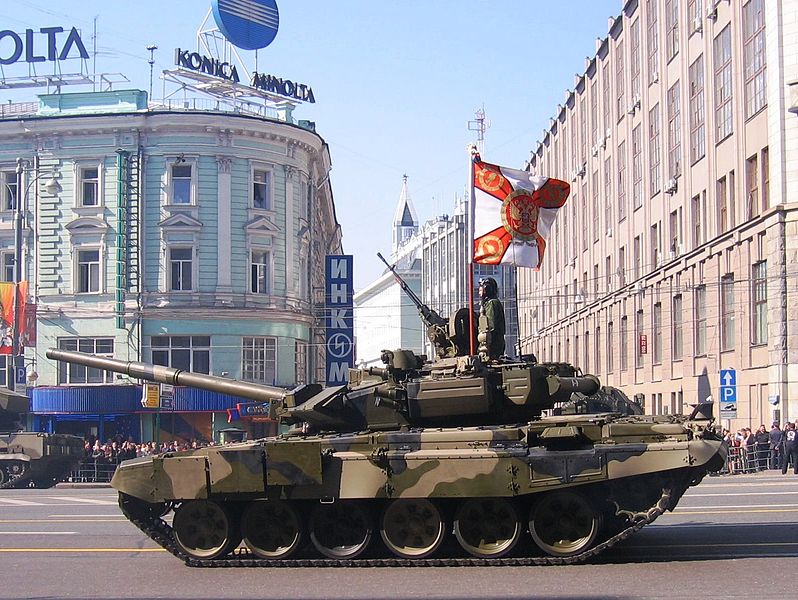
After the turmoil of the end of the USSR and the creation of the Russian federation, and the reconstruction of the army, the T-90 just had to probe into this wealth of experience, engineering, industrial capabilities, and proud legacy. However with the opening to the west, a wealth of technical informations were also available about the real capabilities and technologies used on Western, 3rd generation MBTs. So it was obvious the new tank had to be on par with other western competitors, and on comparable assets. This led to a composite but very efficient model which constitutes the bulk of the Russian armoured division today, soon to be gradually replaced by new the T-14 Armata. The elite divisions are equipped with the even costier T-80s.
Genesis of the T-90
The T-72BU
Back in the 1970s, the T-72 set a new standard for MBTs in USSR, a success story that saw many variants, licence production abroad and countless export derivatives. By the 1980s, it was still by far the best and most current soviet proposition for a MBT of reasonable cost and technological level, compared to the T-64/T-80. It was also an excellent base for improvements, and an export success. The T-72B was considered, back in 1983, the very best of the serie, and served for gradual upgrades, like the T-72BA fitted with the 227 “Kontakt-1” ERA, T-72B obr.1989g (Kontakt-5 ERA) and obr.1990g from which was derived the T-72BU, the direct ancestor of the T-90. This does not prevented two more upgrades to be brought in post-soviet era, the T-72BM “Rogatka” in 2006 and the T-72B3 in 2013, basically a T-72B upgraded to the T-90 standard.
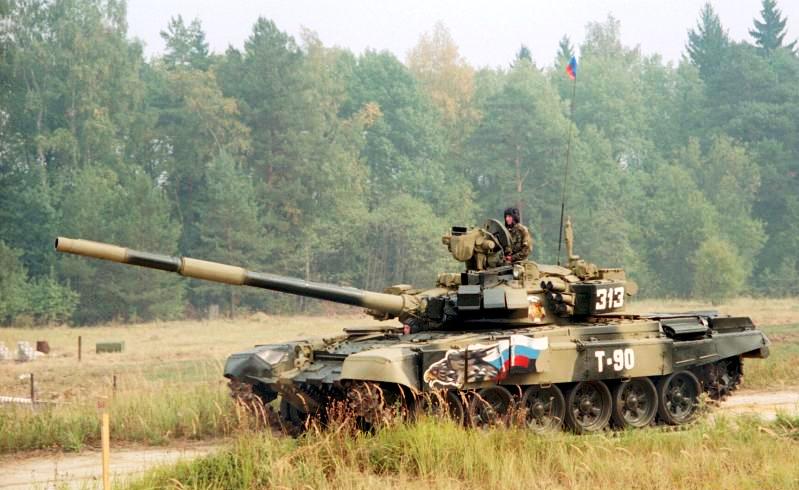
The T-80U
The other crossing which inspired the conception of the T-90 was the T-80U, the very elite MBT of the Russian army. The paradox was that being costier than the T-72, much ended to be built (5400) than the T-90 which was seen at first as a simple evolution of the T-72B, at first called the T-72BU. The T-80 itself was a derivative of the controversial, revolutionary T-64 back in the 1960s. This “elite” lineage came from the Ukrainian KMDB design bureau, and led later to built a purely Ukrainian variant, the T-84. It must be recalled that the T-80 was the first soviet MBT fitted with a turbine, in addition to its regular diesel engine. The latter was rushed out and caused much turmoil and reliability issues, which had to be fixed on the long run. However thanks to this, the T-80 was the fastest Russian MBT ever.
The T-80U appeared in 1985 and was given a full Kontakt5 explosive reactive armour set, along with an improved gunsight and the brand new 9K119 Refleks gun missile system. Five year after its introduction it was given a 1,250-hp engine. It was on this base that the T-90 was partially modelled: Although the core of the T-72B was kept, many components came from the T-80U. By this, engineers Kartsev and Venediktov from the Uralvagonzavod design bureau tried to create a “universal tank”. We know how often these prospects have failed by the past. Indeed the T-90 did not met all the expectations placed in it but was overall more reliable and cheaper to built, maintain and operate than the T-80.
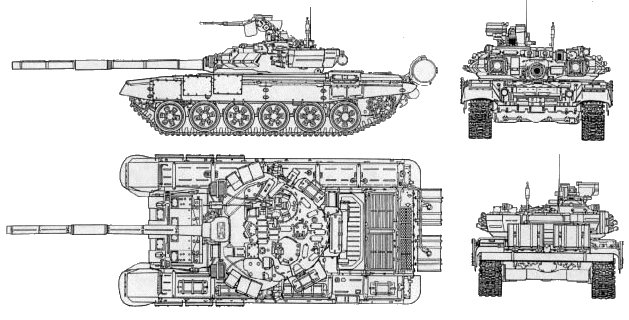
Development history
In 1992, came out a crucial decision from the Russian Ministry of Defence that Russian culd not afford anymore to manufacture, maintain and upgrade two main battle tanks in parallel. However both the T-80U and T-72B production were seen as essential for the local economy of the manufacturers, and the government was found forced to maintain small orders. Indeed, the Omsk plant delivered only five T-80Us while Nizhny Tagil had fifteen T-72s in the meantime, but both expercted firther orders to came, or eventually to be chosen for the unique MBT projected. The only common ground found then was their third generation add-on ERA armour set called Kontakt-5, shared between the two MBTs.
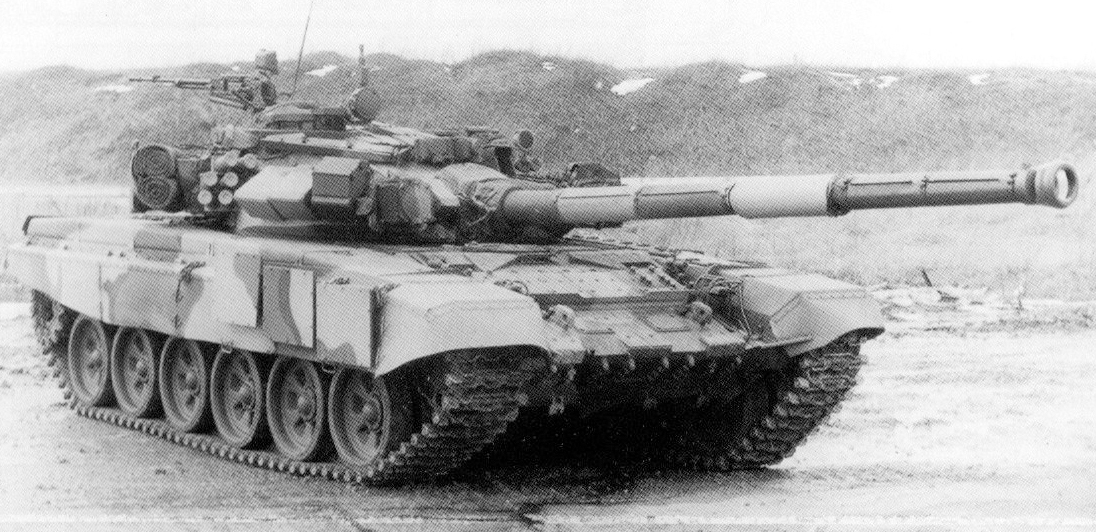
T-72 BU MBT
Among considerations involved were the export policy of the Russian tank industry that leaned strongly towards the T-72 as its champion. but at the same time it was chosen to give it the T-80U sophisticated fire control system, resulting in the T-72BU variant. In the end, the BM was renamed BU after 1990 modifications, and then known as the T-90 program, further developed by the Kartsev-Venediktov Design Bureau (Uralvagonzavod) in Nizhny Tagil. The resulting production hybrid in 1992 was to be built chiefly in Nizhny Tagil, but with components manufactured at Osmk, a plan that seemed to reach general agreement between the state and parties involved.
Basically, the production model was unveiled in 1992 as the T-88 prototype, featuring a 830 hp (620 kW) diesel engine. The preserie was launched in 1993. It also featured an upgraded version of the Kontakt-5 explosive reactive armour on the hull and turret, but had overall the conventional layout of the well-proven T-72. However every single system and sub-system aspect of the T-72 saw improvements, so the general final T-90 product of 1994 could be seen as a well-upgraded variant. One of these modifications also includes the the main gun.
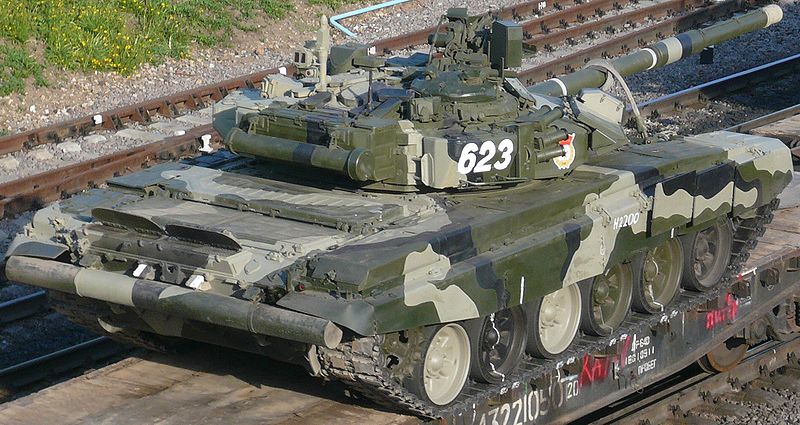
T-90 rear view.
After the start of a mass-production, the T-90S was chosen as an export model, with the usual downgrades. The T-90 was also remarked for its singular “three-tiered” protection level, comprising composite armour (turret), Kontakt-5 (Mark II) ERA and Shtora-1 countermeasures system with a set of evolved smoke mortars and other refinements. This combination really sets apart the T-90 from the previous T-72 MBTs and really incarnates the 3rd generation MBT concept in Russia. The production had eventually ceased in 2015, after the T-14 was first revealed and its own production was scheduled to start in early 2016. By then, around 2260 had been built, which was the lowest production observed for any Russian/Soviet MBT, at a unit price tag of $2.5 million (1999), equivalent to 4.25 million USD in 2011. The T-90MS price was evaluated to 4.5 Million $.
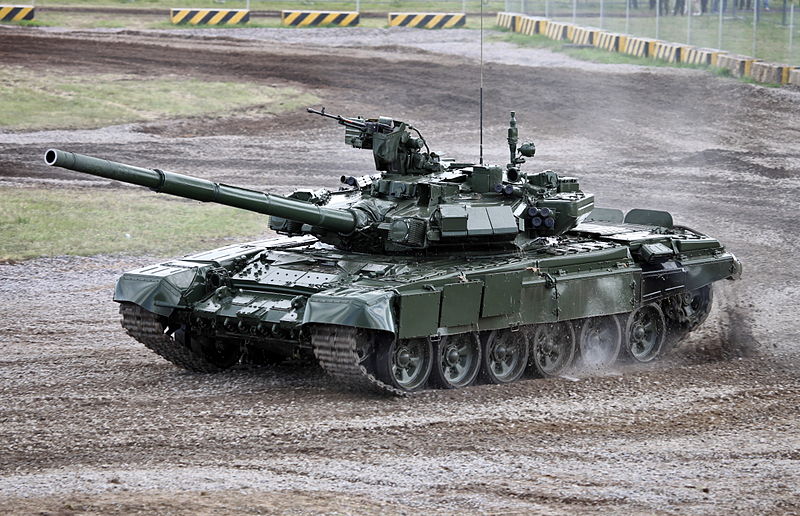
T-90 MBT in a public demonstration in 2012
Design of the T-90
Mobility
The first production version was given basically the same engine than the T-72BU a proven V12 V-84MS diesel giving an output of 840 hp. It was coupled to a 1 kW AB-1-P28 auxiliary power unit which served several subsystems on board, without starting the main engine. This was enough for this 46 tonnes MBT to reach speeds up to 60 kph and around 45 kph cross-country, due to a power to weight ratio of 18.1 hp/tonne (13.5 kW/tonne). The transmission was manual, with 7 forward gears and 1 reverse. This power was passed onto the ground by the same drivetrain than the T-72B, six doubled cast roadwheels per side, and three return rollers, resting on torsion bar suspensions.
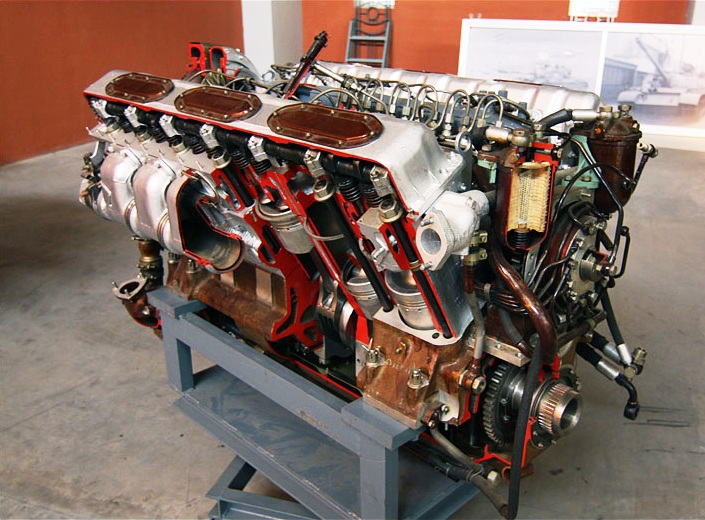
Range was around 550 km with internal capacity of 1.200 L + 400 L auxiliary. Ground pressure was 0.91 kg/sq.cm. Performances were as follows: Fording depth 1.2 m on the move without preparation, and up to 5 m with full preparation and OPVT (snorkel). It was capable to cross a trench 2.8 m wide, a vertical obstacle 0.85 m high, climb a maximum gradient of 30° and stay stable with a maximum tilt of 30°. Like all previous Soviet MBT the T-90 had a simple engine smoke generator. There was also the traditional beam attached to the rear, used for extra grip on the most muddy/snowy terrains. With the addition of additional armour and equipments, the weight rose to 1-2.5 tons and new engines were developed like the 1,000 hp V-92S2 diesel, and eventually the 1,250 hp V-96, giving a 26.3 power-to-weight ratio. Top speed was around 65 kph (governed) but acceleration and torque were much improved.
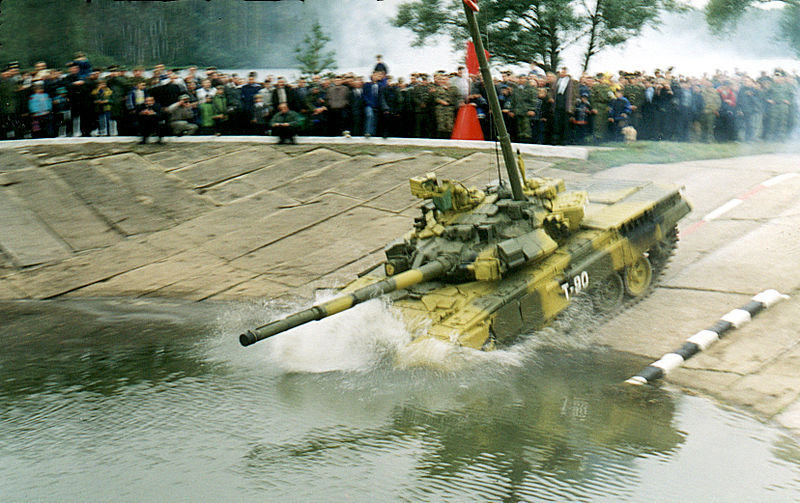
T-90 in demonstration of its Snorkel.
Protection
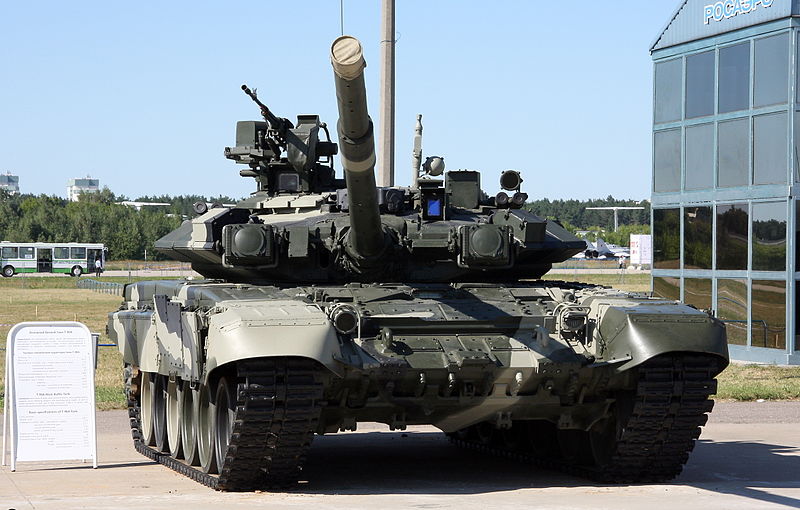
T-90 at ET-2010, Kontakt-5 ERA 3rd generation
The T-90 rested on a three levels protection. First, there was the original T-72 hull, made of welded steel RHA and 50-150 mm strong in direct line of sight. Second, there was a composite level, integrated into chiefly the turret front and sides, well known by the Western experts “Dolly Parton”. It was extremely efficient as proved by tests made in the early 1990s. However it was not enough for the latest generation of “sabot” rounds, super-high velocity APFSDS ammunitions. Therefore in the 1980s was developed the Kontakt Explosive Reactive Armour suite made of explosive bricks. The T-90 adopted the latest ERA suite, Kontakt-5 of third generation in 1993. At the end, the protection provided against APFSDS was equivalent to 550-650 mm RHA with the basic composite armour, which rose to 800–830 mm with the Kontakt-5 ERA. Against HEAT it was 1,000 mm, but reached 1,150–1,350 mm with Kontakt-5.
Also, there was a supplementary “active” form of protection with the mandatory smoke mortars, using 2×6 81mm electric dischargers, firing a wide variety of 3D17 smoke grenades, acting like decoys against enemy infrared sights and ATGM guidance systems. Most importantly, the T-90 was given the Shtora-1 electro-optical jammer. This system jams semiautomatic command to line of sight (SACLOS) for antitank guided missiles, laser rangefinders and target designators. The Shtora was found most effective when used in combination with a hard kill system such as the Arena. The Shtora is also used by the T-80U/UK and the T-84.
Firepower
It rested on the 125mm 2A46M-2 and later 2A46M-5 smoothbore main tank gun. The latter was assisted by a 2E42-4 Zhasmin two-plane electro-mechanical stabilization system, and could fire 6-8 rounds/min. Ammunition storage consisted in 43 rounds, 22 ready-rounds in the carousel below the autoloader system and the others into the hull. The autoloader is basically of the same model developed for the T-72B and allowed to reduce the turret size considerably. There is an autoselector which can rapidly select APFSDS, HEAT and HE-Frag rounds depending of the threat. There is also a hunter-killer mode, the commander can instantaneously passed the target coordinates to the gunner/ballistic computer that lays the gun while concentrating on the next target. The estimated FCS performances are a very high first hit capability on the move at 30 kph off-road, and ranges of up to 5,000 m, including low visibility.
The ammunition were also news for the most, here is the detail:
The gun was also made capable of firing also ATGMs, the 9M119 Svir and 9M119M Refleks-M (AT-11 Sniper-B). This is a 16.5/17.2 kg projectile with a 4.5 kgs Tandem hollow-charge warhead and an effective range of 4,000/5,000 m. it can fly at 350 m/sec for a maximum of 17 seconds, and is capable of defeating up to 900 mm of RHA equivalent. It is compatible with the 2A45 Sprut sb gun. The Svir/Refleks is also used by the Serb M-84AS, T-80, T-84 and is licence-built for the Chinese PLA Type 98 and the next generation of Indian MBTs. Now it is replaced by the improved 9M119M1 (Invar-M).
The secondary armament comprised the usual roof-mounted 12.7 mm Kord Heavy machine gun, which was however remotely-controlled on an AAMG mount Utjos NSVT, with 300 rounds in store. The coaxial armament was the 7.62mm PKMT light machine gun, with ammunition box carries 250 rounds, and a total of 2000 rounds in store. The main gun was conceived to fit and to be retired from the turret through the mantlet without lifting the turret itself up, quite an advantage on the battlefield.Equipments
The hull is equipped with the collective full NBC protection system, with a slight overpressure. In addition there is a GO-27 NBC recon system, and for safety the 3ETs13 Inej automatic fire extinguisher. In option, the T-90 could receive a self-dig-in blade the OPVT deep fording equipment, KMT-7 or KMT-8 mine sweeps kits and optional air conditioner for use in the middle east and for the export versions.
The fire control systems count a 1A45T Irtysh computerized system. Night vision systems comprised the TO1-KO1 Buran-PA main sight with the TPN-4-49-23 passive/active II with an effective range of 1.2/1.5 km. In late production models, this system was replaced by the ESSA (Thales Optronique Catherine-FC TI), also shared by the Leclerc MBT.
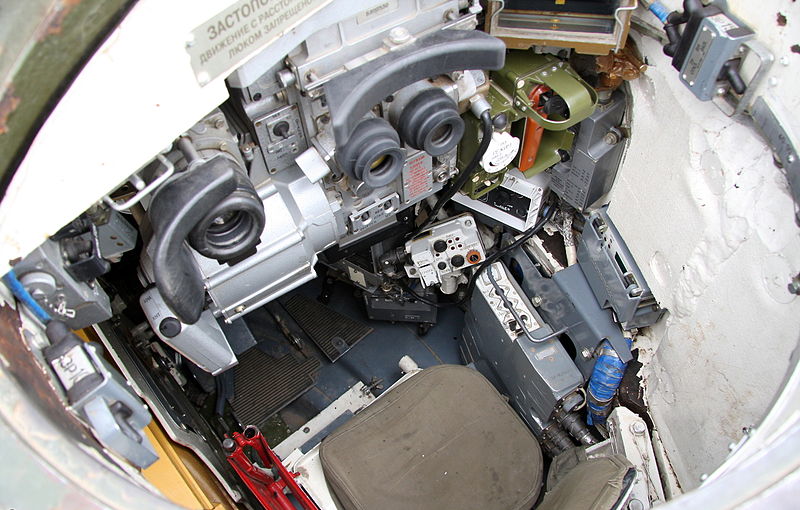
The gunner sight is the 1A43 rangefinder, coupled with the 1G46 day sight, the 9S517 missile guidance system for the ATGMs. The turret/gun sensor that feed the 1V528-1 ballistic computer is the DVE-BS wind gauge. The tank commander is given a PNK-4S system, comprising the TKN-4S Agat-S day/night sight (range 800/700 day/night), while the driver is given the TVN-5 IR night/low visibility sight. In addition to the already powerful Shtora countermeasures system, there is a “Nakidka” thermal/radar/optical shroud. Radio equipment comprised the R-163-50U emiter/receiver, while a R-163-50U and a long range R-163-50K are installed on the command type T-90K. For navigation, there is a TNA-4-3 for the command tank T-90K inertial system, replaced in later batches by a TNA “Gamma” GPS/GLONASS system.
Evolution
The T-90 was called T-72BU until the arrival of the T-90A. This first production was supplemented by the T-90K (Command version) equipped with an extra R-163-50K radio set and the TNA-4-3 navigation equipment. The T-90E was the first export version, downgraded accordingly. However no order was placed.
The T-90A appeared in 1999. For the first time, it featured a fully welded turret of the Object 187 experimental MBT; forever breaking the long tradition of cast turret in MBT design. It is called “Vladimir” in honour of T-90 Chief Designer Vladimir Potkin, died the same year. Details of the new protection provided by this configuration (most probably composites) has not been undisclosed. In addition, this version received the new Chelyabinsk Tractor Plant’s 1000 hp V-92S2 diesel engine and a modern Thales ESSA thermal viewer. The T-90AK is the usual command version.
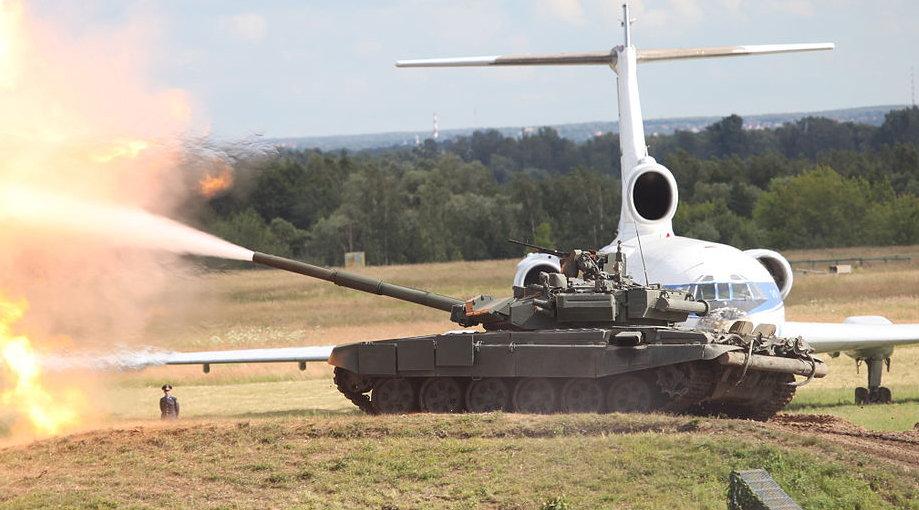 T-90A MBT firing.
T-90A MBT firing.
The T-90S is the export version, produced by by Uralvagonzavod. They receive the 1,000 hp (750 kW) engine but were in effect deprived of the Shtora-1 passive/active protection system. They also have apparently two different turret armour arrays. In cyrillic, it is shown T-90C. The T-90SK command version was also proposed to export with upgraded radio and navigation equipments, plus the Ainet remote-detonation system for HEF rounds. The T-90S “Bhishma” is a modified T-90S with Indian specs.
The T-90AM is the latest occurence (2010s), featuring a complete rebuilding of the turret, equipped with the new advanced FCS “Kalina” completed by a new ballistic computer and integrated combat information and control systems with digital displays for updated battlefield awareness. There is also a new automatic loader, safer and with a faster reloading rate, coupled to an upgraded gun 2A46M-5 main smoothbore gun. The T-90AM is also the first MBT to receive as secondary armament a dedicated rapid-fire remote-controlled anti-aircraft gun “UDP T05BV-1”, of 20 mm caliber. It is capable to engage helicopters and low flying aircrafts.Protection is also upgraded wioth the new ERA set Relikt, replacing the old Kontakt-5. Lastly, it is equiipped with the latest iteration of the venerable deseil, the V96 1130 hp engine. The turet receive extra diital cameras and captors for an enhanced environmental control system especially tailored for urban combat, and a completely upgraded satellite navigation system.
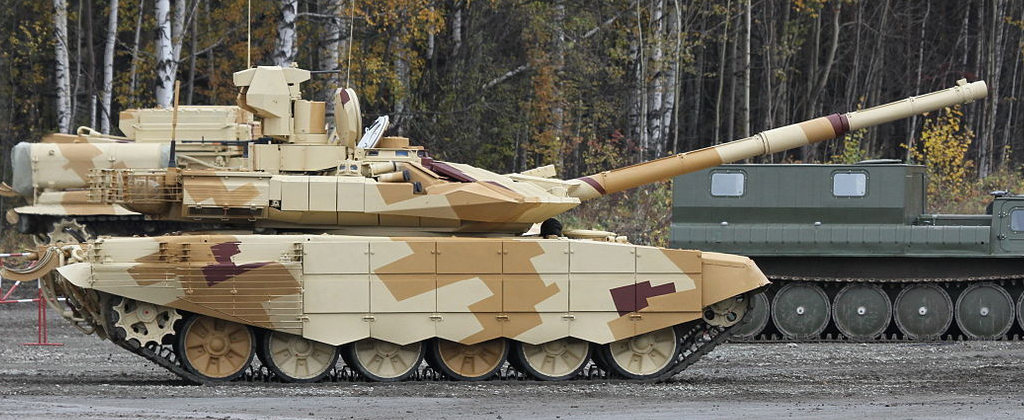
T-90SM at RAE 2013
The T-90MS is the export version of the latter, comprising a PNM Sosna-U gunner sight, UDP T05BV-1 RWS remote-controlled 7.62 mm LMG, GLONASS inertial navigation system and ERA (undisclosed type). The turret also includes a new removable turret bustle (additional storage for eight rounds).
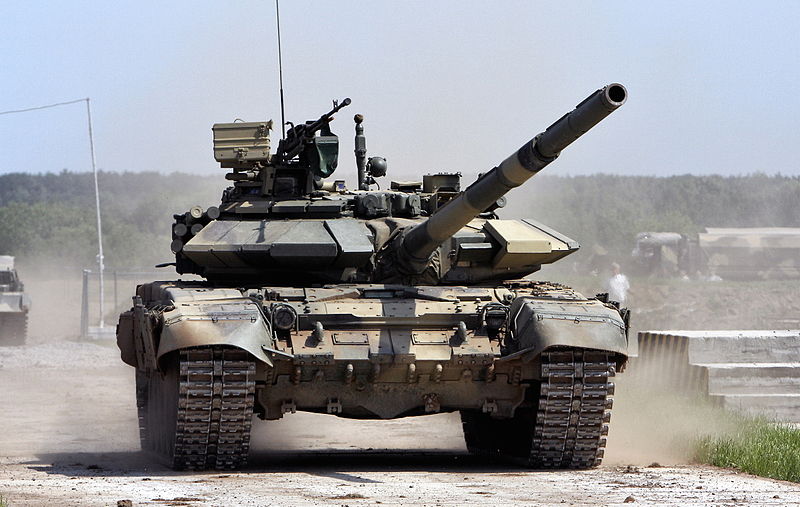
T-90S MBT, the export version
Variants
Exports
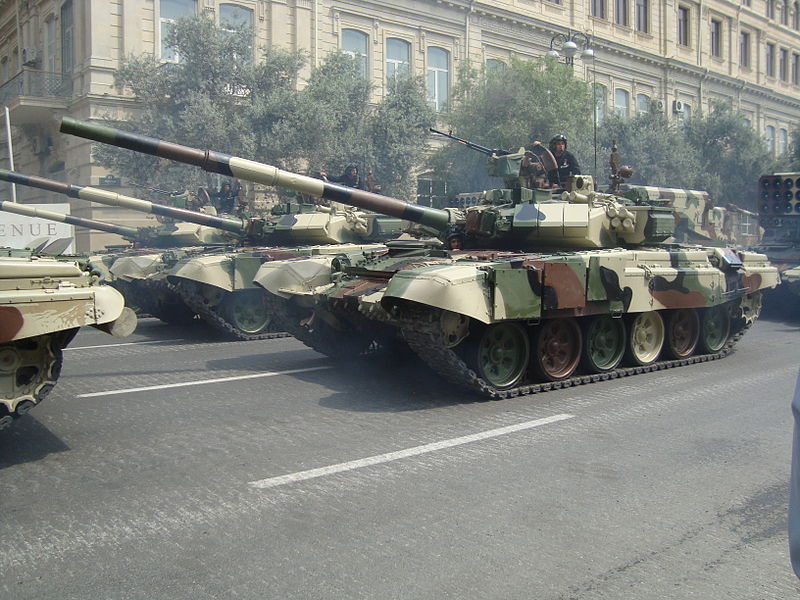
Azeri T-90 in a parade in Baku, 2013.
Algeria
The only country in Maghreb (North Africa) to operate the T-90SA. The army took delivery of 305 T-90SA tanks in a 2008 first batch was delivered, followed by a second by 2013.
Azerbaidjan
The newborn republic adopted naturally the T-72UMG and the T-90SA as their main battle tanks. 100 T-90SA are currently in service, 100 others are in option.
India
The Indian army not only adopted the T-90, it was also built under licence as the T-90AM Bhishma. As for 2015, 862 T-90S were procured in three separate orders, in 2000 and 2006 (300+300). The third order was locally built by Heavy Vehicle Factory (HVF) at Avadi. 24 tanks were delivered by the plant in 2009-10, 51 in 2010-11, and 50 in 2012. Total order is 1,000 by 2020. There is an additional purchase of 354 T-90MS to equip six tank regiments facing the Chinese border. The grand total expected by 2020 will be around 2011 T-90s of all types. The well-upgraded, 3rd/4th generation MBT T-90MS is also called locally Bhishma II.
Turkmenistan
Turkmenistan operates forty T-90S, delivered in 2010 (10) for approximately $30 million followed by another batch of thirty.
Uganda
The only African country to operate this cutting edge, placed an order for 100 T-90S in 2010 ($340 million contract).
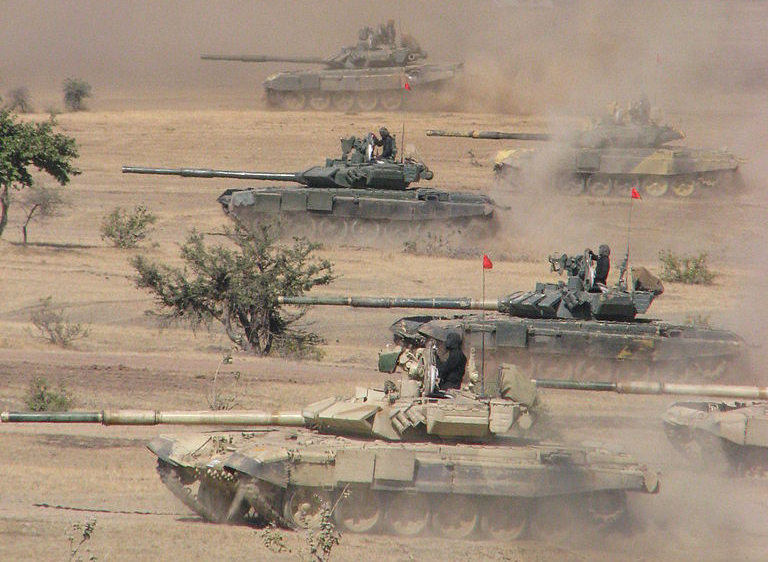
T-90M Bhishma in exercises. Notice the three different liveries.
Active service
In 1995, the Russian Defence Ministry decided to favour the T-90 over the T-80. The latter was indeed was faster and more advanced but also was much more expensive to maintain, with a complicated, delicate and fuel-hungry gas turbine engine. In addition T-80BV performed poorly in during First Chechen War urban combat phases. In September 1995, 107 T-90 had been produced so far and were stationed in the Siberian Military District and Far Eastern Military District the next year. The 1999 T-90A or “Vladimir” was the first with fully welded turret entered service. The T-90A saw combat action in the 1999 Chechen invasion of Dagestan. According to official army reports, one T-90A survived seven RPG hits. Publications of the time argues that the T-90 is the best protecting tank, comparing the effectiveness of the combination of passive/active protection with the overlapping Shtora and Arena systems.
By 2007, 334 T-90s were in service with 5th Guards Tank Division stationed in the Siberian Military District, while seven T-90 served in the Navy. In July 2008, Rosoboronzakaz (the defence contracts federal service) announce the introduction of the T-95 in 2009, however to to budget cuts, the program was shut down and cancelled in may 2010 as it was decided to proceed on the T-90 upgrade and the T-14 program instead. As of today an estimated 930 T-90A. Earlier models had been upgraded to this standard. Only a few T-90AM were built but its not known if it will impact the upgrade of the earlier models until 2020. However it sis much likely that the T-14 Armata being much costier and too cutting edge to be exported, T-90MS and its future iterations would be the main export Russian MBT in the next future.
Russian Arms Expo 2011 – Some T-90s and IFV firing heat decoys.
T-90 related links
T
T-90/A/M specifications
Dimensions (L-w-h)6.55(9,530 oa) x2.32 x2.04 m (21.4 x7.6 x6.7 fts)Total weight, battle ready45.7 Tonnes (91,400 lbs)Crew3 (TC, driver, gunner)PropulsionSee notes. V-84/92/96 12-cyl. diesel 840/940/1250 hp
Power/weight 18.1/20.4/26.3 hp/ton
Top Speed (dep. of engine)42-65 km/h (37-40 mph)Range (dep. of engine)550-700 km (340-430 mi)ArmamentMain: 2A46 125 mm sb gun + ATGM
Secondary: 12.7mm Kord Heavy machine gun, 7.62mm PKMTArmorSee notes. Dolly Parton+ERA Kontakt 5+ShtorTotal productionApprox. 2,260
Gallery
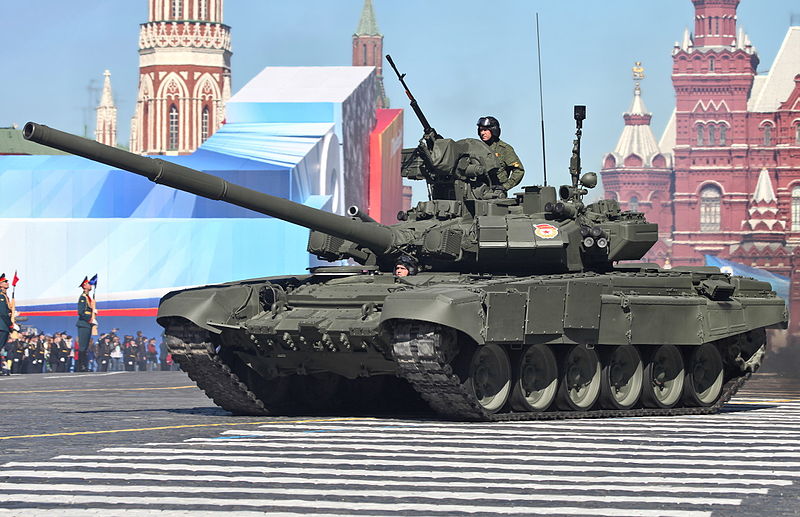
In a sense, the T-90 is the first “Russian” MBT and even the first non-soviet tank ever, as back in 1914-1915 in Tsarist Russia neither the giant Lebedenko (Tsar) tank, the equally giant but more conventional Mendeleev or the small, snail-like Porohovschikova light tank had been pressed into service. In between, there was the Soviet era, with a history of building tanks spanning from the early 1920s with copies of the Renault FT to the T-80 MBT in the 1980s. An entire history of tank designs, which after 1941 confounded itself with the survival of the country in the “Great patriotic war”. An immense country which wide, unencumbered steppes providing an ideal terrain for tanks warfare, but at the same time climactic conditions which pushed mechanics to the extremes.
After the turmoil of the end of the USSR and the creation of the Russian federation, and the reconstruction of the army, the T-90 just had to probe into this wealth of experience, engineering, industrial capabilities, and proud legacy. However with the opening to the west, a wealth of technical informations were also available about the real capabilities and technologies used on Western, 3rd generation MBTs. So it was obvious the new tank had to be on par with other western competitors, and on comparable assets. This led to a composite but very efficient model which constitutes the bulk of the Russian armoured division today, soon to be gradually replaced by new the T-14 Armata. The elite divisions are equipped with the even costier T-80s.
Genesis of the T-90
The T-72BU
Back in the 1970s, the T-72 set a new standard for MBTs in USSR, a success story that saw many variants, licence production abroad and countless export derivatives. By the 1980s, it was still by far the best and most current soviet proposition for a MBT of reasonable cost and technological level, compared to the T-64/T-80. It was also an excellent base for improvements, and an export success. The T-72B was considered, back in 1983, the very best of the serie, and served for gradual upgrades, like the T-72BA fitted with the 227 “Kontakt-1” ERA, T-72B obr.1989g (Kontakt-5 ERA) and obr.1990g from which was derived the T-72BU, the direct ancestor of the T-90. This does not prevented two more upgrades to be brought in post-soviet era, the T-72BM “Rogatka” in 2006 and the T-72B3 in 2013, basically a T-72B upgraded to the T-90 standard.

The T-80U
The other crossing which inspired the conception of the T-90 was the T-80U, the very elite MBT of the Russian army. The paradox was that being costier than the T-72, much ended to be built (5400) than the T-90 which was seen at first as a simple evolution of the T-72B, at first called the T-72BU. The T-80 itself was a derivative of the controversial, revolutionary T-64 back in the 1960s. This “elite” lineage came from the Ukrainian KMDB design bureau, and led later to built a purely Ukrainian variant, the T-84. It must be recalled that the T-80 was the first soviet MBT fitted with a turbine, in addition to its regular diesel engine. The latter was rushed out and caused much turmoil and reliability issues, which had to be fixed on the long run. However thanks to this, the T-80 was the fastest Russian MBT ever.
The T-80U appeared in 1985 and was given a full Kontakt5 explosive reactive armour set, along with an improved gunsight and the brand new 9K119 Refleks gun missile system. Five year after its introduction it was given a 1,250-hp engine. It was on this base that the T-90 was partially modelled: Although the core of the T-72B was kept, many components came from the T-80U. By this, engineers Kartsev and Venediktov from the Uralvagonzavod design bureau tried to create a “universal tank”. We know how often these prospects have failed by the past. Indeed the T-90 did not met all the expectations placed in it but was overall more reliable and cheaper to built, maintain and operate than the T-80.

Development history
In 1992, came out a crucial decision from the Russian Ministry of Defence that Russian culd not afford anymore to manufacture, maintain and upgrade two main battle tanks in parallel. However both the T-80U and T-72B production were seen as essential for the local economy of the manufacturers, and the government was found forced to maintain small orders. Indeed, the Omsk plant delivered only five T-80Us while Nizhny Tagil had fifteen T-72s in the meantime, but both expercted firther orders to came, or eventually to be chosen for the unique MBT projected. The only common ground found then was their third generation add-on ERA armour set called Kontakt-5, shared between the two MBTs.

T-72 BU MBT
Among considerations involved were the export policy of the Russian tank industry that leaned strongly towards the T-72 as its champion. but at the same time it was chosen to give it the T-80U sophisticated fire control system, resulting in the T-72BU variant. In the end, the BM was renamed BU after 1990 modifications, and then known as the T-90 program, further developed by the Kartsev-Venediktov Design Bureau (Uralvagonzavod) in Nizhny Tagil. The resulting production hybrid in 1992 was to be built chiefly in Nizhny Tagil, but with components manufactured at Osmk, a plan that seemed to reach general agreement between the state and parties involved.
Basically, the production model was unveiled in 1992 as the T-88 prototype, featuring a 830 hp (620 kW) diesel engine. The preserie was launched in 1993. It also featured an upgraded version of the Kontakt-5 explosive reactive armour on the hull and turret, but had overall the conventional layout of the well-proven T-72. However every single system and sub-system aspect of the T-72 saw improvements, so the general final T-90 product of 1994 could be seen as a well-upgraded variant. One of these modifications also includes the the main gun.

T-90 rear view.
After the start of a mass-production, the T-90S was chosen as an export model, with the usual downgrades. The T-90 was also remarked for its singular “three-tiered” protection level, comprising composite armour (turret), Kontakt-5 (Mark II) ERA and Shtora-1 countermeasures system with a set of evolved smoke mortars and other refinements. This combination really sets apart the T-90 from the previous T-72 MBTs and really incarnates the 3rd generation MBT concept in Russia. The production had eventually ceased in 2015, after the T-14 was first revealed and its own production was scheduled to start in early 2016. By then, around 2260 had been built, which was the lowest production observed for any Russian/Soviet MBT, at a unit price tag of $2.5 million (1999), equivalent to 4.25 million USD in 2011. The T-90MS price was evaluated to 4.5 Million $.

T-90 MBT in a public demonstration in 2012
Design of the T-90
Mobility
The first production version was given basically the same engine than the T-72BU a proven V12 V-84MS diesel giving an output of 840 hp. It was coupled to a 1 kW AB-1-P28 auxiliary power unit which served several subsystems on board, without starting the main engine. This was enough for this 46 tonnes MBT to reach speeds up to 60 kph and around 45 kph cross-country, due to a power to weight ratio of 18.1 hp/tonne (13.5 kW/tonne). The transmission was manual, with 7 forward gears and 1 reverse. This power was passed onto the ground by the same drivetrain than the T-72B, six doubled cast roadwheels per side, and three return rollers, resting on torsion bar suspensions.

Range was around 550 km with internal capacity of 1.200 L + 400 L auxiliary. Ground pressure was 0.91 kg/sq.cm. Performances were as follows: Fording depth 1.2 m on the move without preparation, and up to 5 m with full preparation and OPVT (snorkel). It was capable to cross a trench 2.8 m wide, a vertical obstacle 0.85 m high, climb a maximum gradient of 30° and stay stable with a maximum tilt of 30°. Like all previous Soviet MBT the T-90 had a simple engine smoke generator. There was also the traditional beam attached to the rear, used for extra grip on the most muddy/snowy terrains. With the addition of additional armour and equipments, the weight rose to 1-2.5 tons and new engines were developed like the 1,000 hp V-92S2 diesel, and eventually the 1,250 hp V-96, giving a 26.3 power-to-weight ratio. Top speed was around 65 kph (governed) but acceleration and torque were much improved.

T-90 in demonstration of its Snorkel.
Protection

T-90 at ET-2010, Kontakt-5 ERA 3rd generation
The T-90 rested on a three levels protection. First, there was the original T-72 hull, made of welded steel RHA and 50-150 mm strong in direct line of sight. Second, there was a composite level, integrated into chiefly the turret front and sides, well known by the Western experts “Dolly Parton”. It was extremely efficient as proved by tests made in the early 1990s. However it was not enough for the latest generation of “sabot” rounds, super-high velocity APFSDS ammunitions. Therefore in the 1980s was developed the Kontakt Explosive Reactive Armour suite made of explosive bricks. The T-90 adopted the latest ERA suite, Kontakt-5 of third generation in 1993. At the end, the protection provided against APFSDS was equivalent to 550-650 mm RHA with the basic composite armour, which rose to 800–830 mm with the Kontakt-5 ERA. Against HEAT it was 1,000 mm, but reached 1,150–1,350 mm with Kontakt-5.
Also, there was a supplementary “active” form of protection with the mandatory smoke mortars, using 2×6 81mm electric dischargers, firing a wide variety of 3D17 smoke grenades, acting like decoys against enemy infrared sights and ATGM guidance systems. Most importantly, the T-90 was given the Shtora-1 electro-optical jammer. This system jams semiautomatic command to line of sight (SACLOS) for antitank guided missiles, laser rangefinders and target designators. The Shtora was found most effective when used in combination with a hard kill system such as the Arena. The Shtora is also used by the T-80U/UK and the T-84.
Firepower
It rested on the 125mm 2A46M-2 and later 2A46M-5 smoothbore main tank gun. The latter was assisted by a 2E42-4 Zhasmin two-plane electro-mechanical stabilization system, and could fire 6-8 rounds/min. Ammunition storage consisted in 43 rounds, 22 ready-rounds in the carousel below the autoloader system and the others into the hull. The autoloader is basically of the same model developed for the T-72B and allowed to reduce the turret size considerably. There is an autoselector which can rapidly select APFSDS, HEAT and HE-Frag rounds depending of the threat. There is also a hunter-killer mode, the commander can instantaneously passed the target coordinates to the gunner/ballistic computer that lays the gun while concentrating on the next target. The estimated FCS performances are a very high first hit capability on the move at 30 kph off-road, and ranges of up to 5,000 m, including low visibility.
The ammunition were also news for the most, here is the detail:
- 3BM-44M APFSDS (range 4,000 m)
- 3BK21B (DU liner), 3BK29 (800 mm RHA equ.), 3BK29M (Triple-tandem charge)
- 3OF26 HE-FRAG with the Ainet fuse setting system
The gun was also made capable of firing also ATGMs, the 9M119 Svir and 9M119M Refleks-M (AT-11 Sniper-B). This is a 16.5/17.2 kg projectile with a 4.5 kgs Tandem hollow-charge warhead and an effective range of 4,000/5,000 m. it can fly at 350 m/sec for a maximum of 17 seconds, and is capable of defeating up to 900 mm of RHA equivalent. It is compatible with the 2A45 Sprut sb gun. The Svir/Refleks is also used by the Serb M-84AS, T-80, T-84 and is licence-built for the Chinese PLA Type 98 and the next generation of Indian MBTs. Now it is replaced by the improved 9M119M1 (Invar-M).
The secondary armament comprised the usual roof-mounted 12.7 mm Kord Heavy machine gun, which was however remotely-controlled on an AAMG mount Utjos NSVT, with 300 rounds in store. The coaxial armament was the 7.62mm PKMT light machine gun, with ammunition box carries 250 rounds, and a total of 2000 rounds in store. The main gun was conceived to fit and to be retired from the turret through the mantlet without lifting the turret itself up, quite an advantage on the battlefield.Equipments
The hull is equipped with the collective full NBC protection system, with a slight overpressure. In addition there is a GO-27 NBC recon system, and for safety the 3ETs13 Inej automatic fire extinguisher. In option, the T-90 could receive a self-dig-in blade the OPVT deep fording equipment, KMT-7 or KMT-8 mine sweeps kits and optional air conditioner for use in the middle east and for the export versions.
The fire control systems count a 1A45T Irtysh computerized system. Night vision systems comprised the TO1-KO1 Buran-PA main sight with the TPN-4-49-23 passive/active II with an effective range of 1.2/1.5 km. In late production models, this system was replaced by the ESSA (Thales Optronique Catherine-FC TI), also shared by the Leclerc MBT.

The gunner sight is the 1A43 rangefinder, coupled with the 1G46 day sight, the 9S517 missile guidance system for the ATGMs. The turret/gun sensor that feed the 1V528-1 ballistic computer is the DVE-BS wind gauge. The tank commander is given a PNK-4S system, comprising the TKN-4S Agat-S day/night sight (range 800/700 day/night), while the driver is given the TVN-5 IR night/low visibility sight. In addition to the already powerful Shtora countermeasures system, there is a “Nakidka” thermal/radar/optical shroud. Radio equipment comprised the R-163-50U emiter/receiver, while a R-163-50U and a long range R-163-50K are installed on the command type T-90K. For navigation, there is a TNA-4-3 for the command tank T-90K inertial system, replaced in later batches by a TNA “Gamma” GPS/GLONASS system.
Evolution
The T-90 was called T-72BU until the arrival of the T-90A. This first production was supplemented by the T-90K (Command version) equipped with an extra R-163-50K radio set and the TNA-4-3 navigation equipment. The T-90E was the first export version, downgraded accordingly. However no order was placed.
The T-90A appeared in 1999. For the first time, it featured a fully welded turret of the Object 187 experimental MBT; forever breaking the long tradition of cast turret in MBT design. It is called “Vladimir” in honour of T-90 Chief Designer Vladimir Potkin, died the same year. Details of the new protection provided by this configuration (most probably composites) has not been undisclosed. In addition, this version received the new Chelyabinsk Tractor Plant’s 1000 hp V-92S2 diesel engine and a modern Thales ESSA thermal viewer. The T-90AK is the usual command version.
 T-90A MBT firing.
T-90A MBT firing.The T-90S is the export version, produced by by Uralvagonzavod. They receive the 1,000 hp (750 kW) engine but were in effect deprived of the Shtora-1 passive/active protection system. They also have apparently two different turret armour arrays. In cyrillic, it is shown T-90C. The T-90SK command version was also proposed to export with upgraded radio and navigation equipments, plus the Ainet remote-detonation system for HEF rounds. The T-90S “Bhishma” is a modified T-90S with Indian specs.
The T-90AM is the latest occurence (2010s), featuring a complete rebuilding of the turret, equipped with the new advanced FCS “Kalina” completed by a new ballistic computer and integrated combat information and control systems with digital displays for updated battlefield awareness. There is also a new automatic loader, safer and with a faster reloading rate, coupled to an upgraded gun 2A46M-5 main smoothbore gun. The T-90AM is also the first MBT to receive as secondary armament a dedicated rapid-fire remote-controlled anti-aircraft gun “UDP T05BV-1”, of 20 mm caliber. It is capable to engage helicopters and low flying aircrafts.Protection is also upgraded wioth the new ERA set Relikt, replacing the old Kontakt-5. Lastly, it is equiipped with the latest iteration of the venerable deseil, the V96 1130 hp engine. The turet receive extra diital cameras and captors for an enhanced environmental control system especially tailored for urban combat, and a completely upgraded satellite navigation system.

T-90SM at RAE 2013
The T-90MS is the export version of the latter, comprising a PNM Sosna-U gunner sight, UDP T05BV-1 RWS remote-controlled 7.62 mm LMG, GLONASS inertial navigation system and ERA (undisclosed type). The turret also includes a new removable turret bustle (additional storage for eight rounds).

T-90S MBT, the export version
Variants
- BREM-72 Armoured recovery vehicle.
- MTU-90 Bridge layer tank with MLC50 bridge.
- IMR-3 Combat engineer vehicle.
- BMR-3 Mine clearing vehicle.
Exports

Azeri T-90 in a parade in Baku, 2013.
Algeria
The only country in Maghreb (North Africa) to operate the T-90SA. The army took delivery of 305 T-90SA tanks in a 2008 first batch was delivered, followed by a second by 2013.
Azerbaidjan
The newborn republic adopted naturally the T-72UMG and the T-90SA as their main battle tanks. 100 T-90SA are currently in service, 100 others are in option.
India
The Indian army not only adopted the T-90, it was also built under licence as the T-90AM Bhishma. As for 2015, 862 T-90S were procured in three separate orders, in 2000 and 2006 (300+300). The third order was locally built by Heavy Vehicle Factory (HVF) at Avadi. 24 tanks were delivered by the plant in 2009-10, 51 in 2010-11, and 50 in 2012. Total order is 1,000 by 2020. There is an additional purchase of 354 T-90MS to equip six tank regiments facing the Chinese border. The grand total expected by 2020 will be around 2011 T-90s of all types. The well-upgraded, 3rd/4th generation MBT T-90MS is also called locally Bhishma II.
Turkmenistan
Turkmenistan operates forty T-90S, delivered in 2010 (10) for approximately $30 million followed by another batch of thirty.
Uganda
The only African country to operate this cutting edge, placed an order for 100 T-90S in 2010 ($340 million contract).

T-90M Bhishma in exercises. Notice the three different liveries.
Active service
In 1995, the Russian Defence Ministry decided to favour the T-90 over the T-80. The latter was indeed was faster and more advanced but also was much more expensive to maintain, with a complicated, delicate and fuel-hungry gas turbine engine. In addition T-80BV performed poorly in during First Chechen War urban combat phases. In September 1995, 107 T-90 had been produced so far and were stationed in the Siberian Military District and Far Eastern Military District the next year. The 1999 T-90A or “Vladimir” was the first with fully welded turret entered service. The T-90A saw combat action in the 1999 Chechen invasion of Dagestan. According to official army reports, one T-90A survived seven RPG hits. Publications of the time argues that the T-90 is the best protecting tank, comparing the effectiveness of the combination of passive/active protection with the overlapping Shtora and Arena systems.
By 2007, 334 T-90s were in service with 5th Guards Tank Division stationed in the Siberian Military District, while seven T-90 served in the Navy. In July 2008, Rosoboronzakaz (the defence contracts federal service) announce the introduction of the T-95 in 2009, however to to budget cuts, the program was shut down and cancelled in may 2010 as it was decided to proceed on the T-90 upgrade and the T-14 program instead. As of today an estimated 930 T-90A. Earlier models had been upgraded to this standard. Only a few T-90AM were built but its not known if it will impact the upgrade of the earlier models until 2020. However it sis much likely that the T-14 Armata being much costier and too cutting edge to be exported, T-90MS and its future iterations would be the main export Russian MBT in the next future.
Russian Arms Expo 2011 – Some T-90s and IFV firing heat decoys.
T-90 related links
T
T-90/A/M specifications
Dimensions (L-w-h)6.55(9,530 oa) x2.32 x2.04 m (21.4 x7.6 x6.7 fts)Total weight, battle ready45.7 Tonnes (91,400 lbs)Crew3 (TC, driver, gunner)PropulsionSee notes. V-84/92/96 12-cyl. diesel 840/940/1250 hp
Power/weight 18.1/20.4/26.3 hp/ton
Top Speed (dep. of engine)42-65 km/h (37-40 mph)Range (dep. of engine)550-700 km (340-430 mi)ArmamentMain: 2A46 125 mm sb gun + ATGM
Secondary: 12.7mm Kord Heavy machine gun, 7.62mm PKMTArmorSee notes. Dolly Parton+ERA Kontakt 5+ShtorTotal productionApprox. 2,260
Gallery

